小学英语语法总结及练习题
小学英语语法汇总,含练习题及答案2020.10
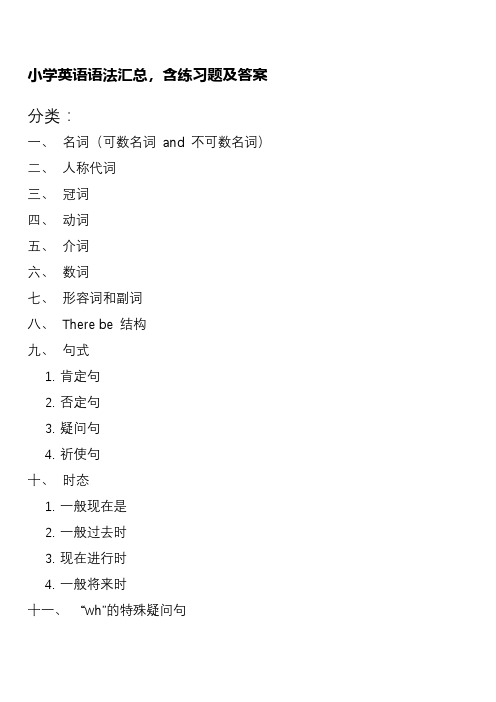
小学英语语法汇总,含练习题及答案分类:一、名词(可数名词and 不可数名词)二、人称代词三、冠词四、动词五、介词六、数词七、形容词和副词八、There be 结构九、句式1.肯定句2.否定句3.疑问句4.祈使句十、时态1.一般现在是2.一般过去时3.现在进行时4.一般将来时十一、“wh”的特殊疑问句一、 名词(表示任何事物的名称)专有名词:1.特定的人、地方、机构等专有名称。
第一个字母通常要大写。
(e.g. Toby 、Shanghai,Bank of China.)2.星期、月份、节日、学科、报刊名称也属于专有名词。
普通名词:1.个体名词----表示某类人或东西中的个体。
如(student 、 desk )2.集体名词----表示若干个体组成的结合体。
如(class 、 family )3.物质名词----表示无法分为个体的物质名词。
如(water 、 rice 、 sand 、 hair )4.抽象名词----表示情感、状态、品质等抽象名词。
如(love 、carelessness )个体名词和集体名词多数可以 用数目来计算,称为可数名词,有单数、复数形式 物质名词和抽象名词通常无法用数目计算,称为不可数名词,一般只有一种形式。
1.由元音字母的变化构成:man-men/ tooth-teeth/ foot-feet/ mouse-mice/ woman-women2.单复数形式一样的名词:sheep / deer / fish (也可以fishes)3.有些名词变成复数时加-en: child-children /ox-oxenPractices:1.peach2.zoo3. glass4.foxdy6. Policewoman7. house8.photo 9. monkey 10. wife11.rose 12. path 13. judge 14.map二、人称代词主格一般用在句子前面,宾格用在动词后面,I am Li Le. Call me le le.形容词性人称代词指“某人的什么”,my book(我的书),your puppy.(你的小狗)名词性人称代词指什么是“某人的”,This book is mime(这本书是我的)Practices:1.He (他)is my brother .2.I had a letter from her(她).3.It’s all right; it’s only me(我)4.Today we (我们)went in our(我们的)car;tomorrow we(我们) are going in theirs(他们的)5.I(我)lend my(我的)books gladly to my(我的)friends and to yours(你的).6.Can you help me (我)with my (我的)English?7.When you(你)go to see your(你的)father, please take these books to him(他)。
PEP小学英语语法要点及精选习题-答案
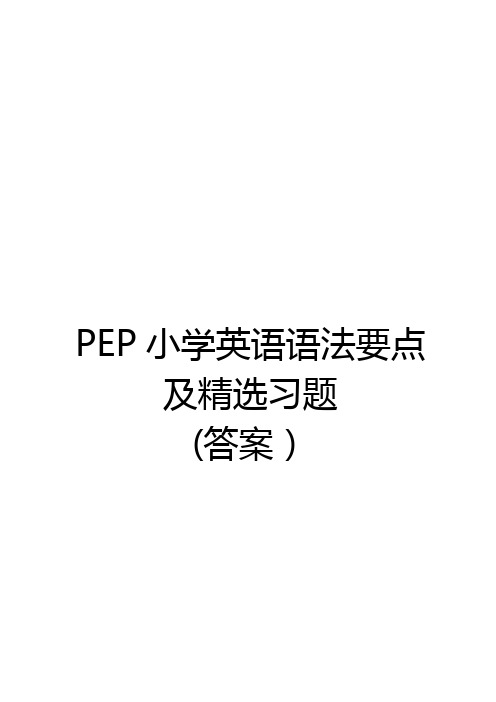
一、写出下列动词的现在分词:
play_playing_run__running__swim __swimming__make__making___
go___going___ski__skiing___
read_reading_have__having__sing __singing___dance_dancing__
3.What are you doingin the playground?
4.What isTomdoing in his study?
四、一般将来时
一、填空。
1。我打算明天和朋友去野炊。
Iamgoingtohave a picnic with my friends。
Iwillhave a picnic with my friends。
come - camehave - hadeat - atetake - took
run - ransing - sangput - putmake - made
read - readwrite - wrotedraw - drewdrink - drank
fly - flewride - rodespeak - spokesweep - swept
19. Davidwill givea puppet show next Monday.
20. Iis planningfor my study now
五、一般过去时
am,is - wasare - weredo - didsee - saw
say - saidgive - gaveget - gotgo - went
looklooksdrawdrawsdropdropsgivegives
(完整)小学英语六年级总复习语法及练习题(一).docx
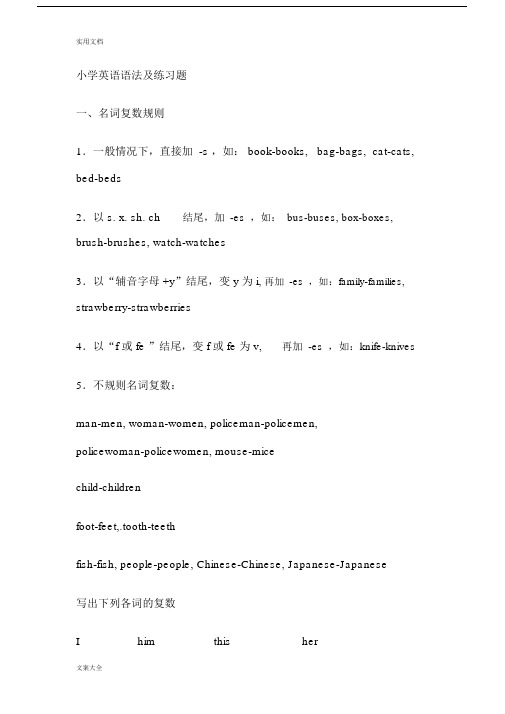
小学英语语法及练习题一、名词复数规则1.一般情况下,直接加 -s ,如: book-books, bag-bags, cat-cats, bed-beds2.以 s. x. sh. ch结尾,加-es,如:bus-buses, box-boxes, brush-brushes, watch-watches3.以“辅音字母 +y”结尾,变 y 为 i,再加-es,如:family-families, strawberry-strawberries4.以“f 或 fe ”结尾,变 f 或 fe 为 v,再加-es,如:knife-knives 5.不规则名词复数:man-men, woman-women, policeman-policemen,policewoman-policewomen, mouse-micechild-childrenfoot-feet,.tooth-teethfish-fish, people-people, Chinese-Chinese, Japanese-Japanese写出下列各词的复数I _________him _________this ___________her ______watch _______child _______photo ________diary ______day________ foot________ book_______ dress ________tooth_______ sheep ______box_______ strawberry _____thief _______yo-yo ______ peach______ sandwich ______man______ woman_______ paper_______juice___________ water________ milk________ rice__________ tea__________二、一般现在时一般现在时基本用法介绍【No. 1 】一般现在时的功能1. 表示事物或人物的特征、状态。
(完整版)小学英语语法及练习题
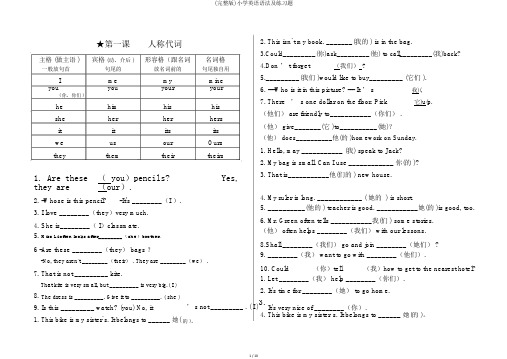
★第一课人称代词主格 (做主语 )宾格 (动、介后 )形容格(跟名词名词格一般放句首句尾的放名词前的句尾独自用I me my mine youyouyouryour ( 你,你们 )he him his his she her her hers it it its its weus our Ours theythemtheirtheirs1. Are these ( you )pencils? Yes,they are (our ).2. This isn`t my book. _______(我的 ) is in the bag.3.Could_________(你)ask_________(他) to call_________(我)back?4.Don ’ t forget (我们) ?5._________(我们 )would like to buy_________ (它们 ).6. ---Who is it in this picture? --- It ’ s 我)(.7. There ’ s one dollar on the floor. Pick它)u(p.(他们) are friendly to___________(你们) .(他) give_______(它 )to__________(她)?(他) does__________他(的 )homework on Sunday.1. Hello, may ___________ (我) speak to Jack?2. My bag is small. Can I use ____________ 你(的 )?3. That is___________他(们的 ) new house.2. -Whose is this pencil?-It's ________(I ).4. My ruler is long. ____________ ( 她的 ) is short.5. __________(他的 ) teacher is good. ___________她(的 )is good, too. 3. I love ________(they )very much.6. Mr. Green often tells ___________我(们 ) some stories. 4. She is________( I )classmate. (他) often helps ________(我们) with our lessons.5.Miss Li often looks after________(she )brother.6 -Are these ________(they ) bags ?8.Shall ________(我们) go and join ________(她们) ? 9. ________(我) want to go with ________(他们).-No, they aren't ________(their ) . They are ________(we ) .7. That is not _________ kite.10. Could(你)tell (我)how to get to the nearest hotel? 1. Let ________(我) help ________(你们). That kite is very small, but _________ is very big.( I )It's time for ________(她) to go home.8.2. The dress is _________. Give it to _________. ( she )9. Is this _________ watch? (you) No, it’ s not _________ . ( I )3.It's very nice of ________(你).1. This bike is my sister`s. It belongs to ______ 她( 4. This bike is my sister`s. It belongs to ______ 她(的 )。
小学生英语语法练习题5篇
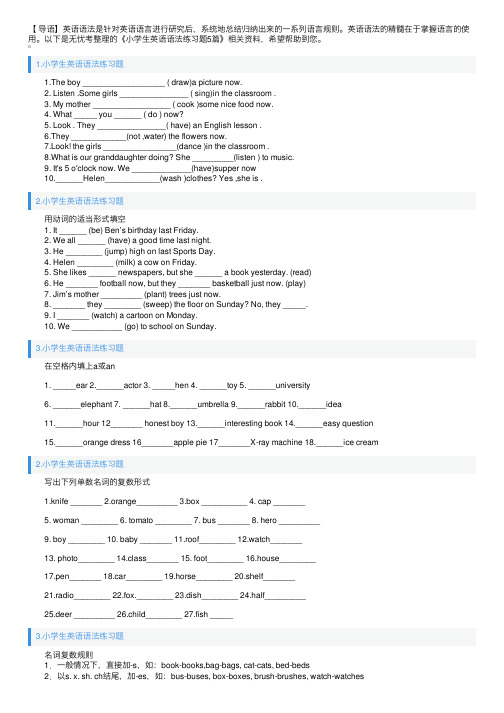
【导语】英语语法是针对英语语⾔进⾏研究后,系统地总结归纳出来的⼀系列语⾔规则。
英语语法的精髓在于掌握语⾔的使⽤。
以下是⽆忧考整理的《⼩学⽣英语语法练习题5篇》相关资料,希望帮助到您。
1.⼩学⽣英语语法练习题 1.The boy __________________ ( draw)a picture now. 2. Listen .Some girls _______________ ( sing)in the classroom . 3. My mother _________________ ( cook )some nice food now. 4. What _____ you ______ ( do ) now? 5. Look . They _______________( have) an English lesson . 6.They ____________(not ,water) the flowers now. 7.Look! the girls ________________(dance )in the classroom . 8.What is our granddaughter doing? She _________(listen ) to music. 9. It's 5 o'clock now. We _____________(have)supper now 10.______Helen____________(wash )clothes? Yes ,she is .2.⼩学⽣英语语法练习题 ⽤动词的适当形式填空 1. It ______ (be) Ben’s birthday last Friday. 2. We all ______ (have) a good time last night. 3. He ________ (jump) high on last Sports Day. 4. Helen ________ (milk) a cow on Friday. 5. She likes ______ newspapers, but she ______ a book yesterday. (read) 6. He _______ football now, but they _______ basketball just now. (play) 7. Jim’s mother _________ (plant) trees just now. 8. _______ they ________ (sweep) the floor on Sunday? No, they _____. 9. I _______ (watch) a cartoon on Monday. 10. We ___________ (go) to school on Sunday.3.⼩学⽣英语语法练习题 在空格内填上a或an1. _____ear2.______actor3. _____hen4. ______toy5. ______university6. ______elephant7. ______hat8.______umbrella9.______rabbit 10.______idea 11.______hour 12_______ honest boy 13.______interesting book 14.______easy question 15.______orange dress 16_______apple pie 17_______X-ray machine 18.______ice cream2.⼩学⽣英语语法练习题 写出下列单数名词的复数形式1.knife _______2.orange_________3.box __________4. cap _______5. woman ________6. tomato ________7. bus _______8. hero _________ 9. boy ________ 10. baby _______ 11.roof________ 12.watch_______ 13. photo________ 14.class_______ 15. foot________ 16.house________ 17.pen_______ 18.car________ 19.horse________ 20.shelf_______ 21.radio________ 22.fox.________ 23.dish________ 24.half_________ 25.deer _________ 26.child________ 27.fish _____3.⼩学⽣英语语法练习题 名词复数规则 1.⼀般情况下,直接加-s,如:book-books,bag-bags, cat-cats, bed-beds 2.以s. x. sh. ch结尾,加-es,如:bus-buses, box-boxes, brush-brushes, watch-watches 3.以“辅⾳字母+y”结尾,变y为i, 再加-es,如:family-families, strawberry-strawberries 4.以“f或fe”结尾,变f或fe为v, 再加-es,如:knife-knives 5.不规则名词复数: man-men, woman-women, policeman-policemen, policewoman-policewomen,mouse-mice, child-children, foot-feet, tooth-teeth, fish-fish, people-people, Chinese-Chinese, Japanese-Japanese 练习:写出下列各词的复数 I _________him _________this ___________her ______ watch _______child _______photo ________diary ______ day________ foot________ book_______ dress ________ tooth_______ sheep ______box_______ strawberry _____ thief _______yo-yo ______ peach______ sandwich ______ man______ woman_______ paper_______ juice___________ water________ milk________ rice__________ tea__________。
小学英语语法大全-附练习题(附答案)

Contents 第一章名词1.名词的数2.名词的格第二章代词1.人称代词2.物主代词第三章冠词与数词1.冠词2.数词第四章一般现在时态第五章现在进行时态第六章句型1.述句2.疑问句3.祈使句4.There be 句型与have\ has第七章总结考试第一章名词(Noun)名词的概念在生活中,我们会接触到各种各样的人和事物,用来表示这些人或事物名称的词就是名词。
一、名词的数名词的数指名词的单数和复数形式。
可数名词表示“一个”时用单数,“两个以上”时用复数;不可数名词表示量时,通常用“数词+单位+of+物质名词”的形式,如 a piece of bread (一片面包),变为复数时,只须将单位名词变为复数,如:two pieces of bread(两片面包)。
*名词复数的构成法则1. 一般情况下在词尾加 s. 词尾读音shop --- shops (商店) 在清辅音后读 [ s ]bag --- bags (书包) 在浊辅音后读 [ z ]window --- windows (窗户) 在元音后读 [ z]2. 以 s, x, sh, ch 结尾的单词在词尾加es。
class --- classes (班级) 词尾读音[ iz ]box --- boxes (盒子)match --- matches (比赛)brush --- brushes (刷子)3. 以“辅音字母 +y”结尾的词,变y为 i 加es.story --- stories (故事) 词尾读音[ iz ]4. 以“元音字母 +y”结尾的词,在词尾直接加 skey --- keys 词尾读音[ z ]monkey --- monkeys5.以“o”结尾的名词,复数一般在词尾加“s”, 但个别加“es”tomato --- tomatoes (西红柿) 词尾读音[ z ]potato --- potatoes (土豆)zoo --- zoos (动物园)photo --- photos (照片)*(以“o”结尾,复数加“es”)口诀:黑人(Negro)英雄(hero),左手拿着西红柿(tomato),右手拿着破土豆(potato),头顶一个大芒果(mango)。
小学英语语法练习题及答案

小学英语语法练习题及答案一、名词练习1. 单复数名词- 单数名词变复数名词:- Book → Books- Child → Children- Foot → Feet2. 名词所有格- 表示所有关系的名词:- The cat's tail (猫的尾巴)- My father's car (我爸爸的车)答案:1.- Books- Children- Feet2.- The cat has a long tail.- His car is new.二、动词练习1. 动词的时态- 现在进行时:- She is reading a book.- 一般过去时:- They walked to school.2. 动词的第三人称单数- He plays football every day.答案:1.- She is reading a book now.- Yesterday, they walked to school. 2.- He plays football every day.三、形容词和副词练习1. 形容词比较级和最高级- 比较级:Bigger, faster- 最高级:The biggest, the fastest2. 副词的使用- 副词修饰动词:- She runs quickly.答案:1.- The cat is bigger than the dog.- This is the fastest car in the race.2.- She runs quickly to catch the bus.四、代词练习1. 人称代词- 主格代词:I, you, he, she, it- 宾格代词:me, you, him, her, it2. 物主代词- 形容词性物主代词:my, your, his, her, its - 名词性物主代词:mine, yours, his, hers, its答案:1.- I am going to the park. (主格)- Can you pass the ball to me? (宾格)2.- This is my book. (形容词性)- The book is mine. (名词性)五、介词练习1. 表示时间的介词- In, on, at- In the morning, on Monday, at 5 o'clock2. 表示地点的介词- In, on, at, to- In the classroom, on the desk, at the zoo, to the library答案:1.- I wake up in the morning.- We have a party on my birthday.- The meeting starts at 3 PM.2.- The cat is in the box.- The book is on the table.- We go to the park.六、疑问句练习1. 一般疑问句- Do you like apples?- Does she have a sister?2. 特殊疑问句- What is your name?- Where are you going?答案:1.- Yes, I do.- No, she doesn't.2.- My name is Tom.- I am going to the cinema.。
(完整)小学英语六年级总复习语法及练习题(一)
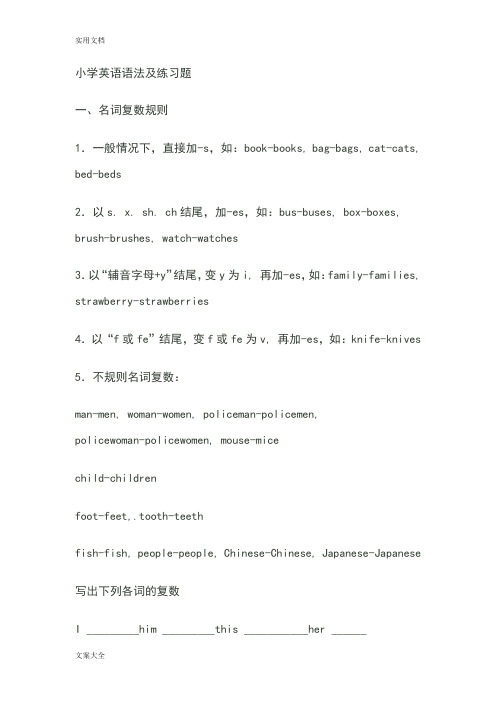
小学英语语法及练习题一、名词复数规则1.一般情况下,直接加-s,如:book-books, bag-bags, cat-cats, bed-beds2.以s. x. sh. ch结尾,加-es,如:bus-buses, box-boxes, brush-brushes, watch-watches3.以“辅音字母+y”结尾,变y为i, 再加-es,如:family-families, strawberry-strawberries4.以“f或fe”结尾,变f或fe为v, 再加-es,如:knife-knives 5.不规则名词复数:man-men, woman-women, policeman-policemen,policewoman-policewomen, mouse-micechild-childrenfoot-feet,.tooth-teethfish-fish, people-people, Chinese-Chinese, Japanese-Japanese 写出下列各词的复数I _________him _________this ___________her ______watch _______child _______photo ________diary ______day________ foot________ book_______ dress ________tooth_______ sheep ______box_______ strawberry _____thief _______yo-yo ______ peach______ sandwich ______man______ woman_______ paper_______ juice___________ water________ milk________ rice__________ tea__________ 二、一般现在时一般现在时基本用法介绍【No. 1】一般现在时的功能1.表示事物或人物的特征、状态。
(完整版)小学英语语法总结及练习题

小学英语语法总结及练习一、名词复数规则1.一般状况下,直接加-s,如: book-books, bag-bags, cat-cats, bed-beds2.以 s. x. sh. ch 结尾,加 -es,如: bus-buses, box-boxes, brush-brushes, watch-watches 3.以“辅音字母 y”结尾,变 y 为 i, 再加 -es,如: family-families, strawberry-strawberries 4.以“f或 fe ”结尾,变 f 或 fe 为 v, 再加 -es,如: knife-knives , leaf—— leaves 5.不规则名词复数:man-men, woman-women, policeman-policemen, policewoman-policewomen,child-children , foot-feet, tooth-teethfish-fish, deer-deer, sheep-sheep, people-people, Chinese-Chinese,Japanese-Japanese写出以下各词的复数I _________him _________this ___________her ______watch _______child _______photo ________diary ______day________foot________book_______dress ________tooth_______sheep ______box_______strawberry _____peach______sandwich ______dish_______bus_______man______woman_______二、一般此刻时一般此刻时基本用法介绍:【No. 1 】一般此刻时的功能1. 表示事物或人物的特点、状态。
小学英语语法练习
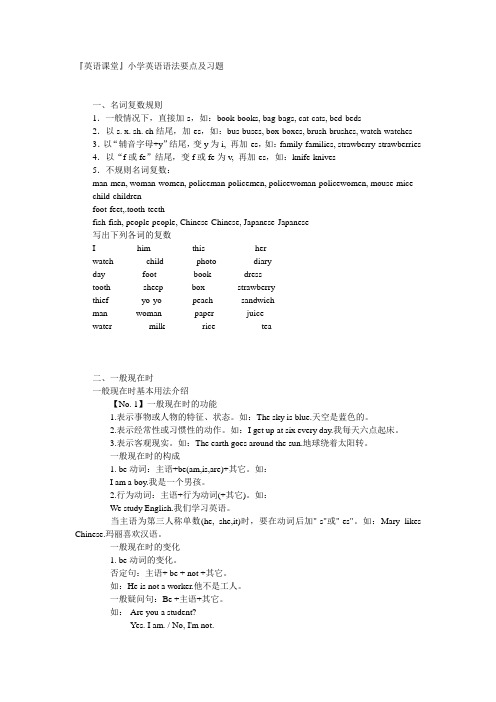
『英语课堂』小学英语语法要点及习题一、名词复数规则1.一般情况下,直接加-s,如:book-books, bag-bags, cat-cats, bed-beds2.以s. x. sh. ch结尾,加-es,如:bus-buses, box-boxes, brush-brushes, watch-watches 3.以“辅音字母+y”结尾,变y为i, 再加-es,如:family-families, strawberry-strawberries 4.以“f或fe”结尾,变f或fe为v, 再加-es,如:knife-knives5.不规则名词复数:man-men, woman-women, policeman-policemen, policewoman-policewomen, mouse-mice child-childrenfoot-feet,.tooth-teethfish-fish, people-people, Chinese-Chinese, Japanese-Japanese写出下列各词的复数I _________him _________this ___________her ______watch _______child _______photo ________diary ______day________ foot________ book_______ dress ________tooth_______ sheep ______box_______ strawberry _____thief _______yo-yo ______ peach______ sandwich ______man______ woman_______ paper_______ juice___________water________ milk________ rice__________ tea__________二、一般现在时一般现在时基本用法介绍【No. 1】一般现在时的功能1.表示事物或人物的特征、状态。
小学二年级英语语法及练习题
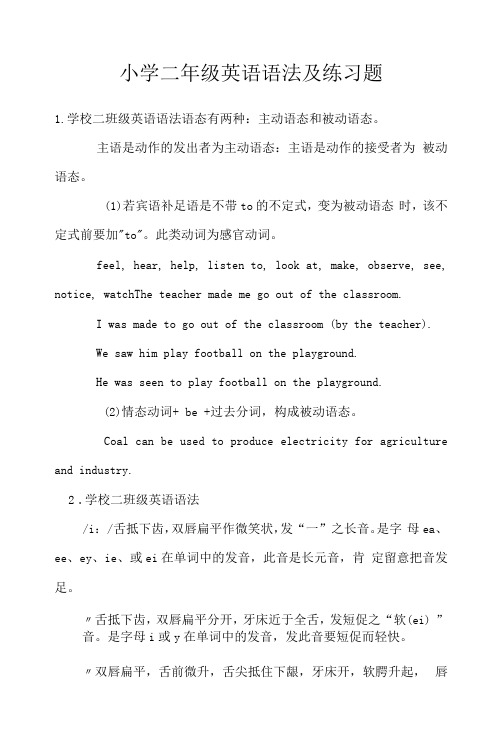
小学二年级英语语法及练习题1.学校二班级英语语法语态有两种:主动语态和被动语态。
主语是动作的发出者为主动语态:主语是动作的接受者为被动语态。
(1)若宾语补足语是不带to的不定式,变为被动语态时,该不定式前要加"to"。
此类动词为感官动词。
feel, hear, help, listen to, look at, make, observe, see, notice, watchThe teacher made me go out of the classroom.I was made to go out of the classroom (by the teacher).We saw him play football on the playground.He was seen to play football on the playground.(2)情态动词+ be +过去分词,构成被动语态。
Coal can be used to produce electricity for agriculture and industry.2.学校二班级英语语法/i:/舌抵下齿,双唇扁平作微笑状,发“一”之长音。
是字母ea、ee、ey、ie、或ei在单词中的发音,此音是长元音,肯定留意把音发足。
〃舌抵下齿,双唇扁平分开,牙床近于全舌,发短促之“软(ei) ”音。
是字母i或y在单词中的发音,发此音要短促而轻快。
〃双唇扁平,舌前微升,舌尖抵住下龈,牙床开,软腭升起,唇自然开放。
是字母a在闭音节或重读闭音节中的发音/e/舌近硬腭,舌尖顶下齿,牙床半开半合,作微笑状。
是字母e 或ea在单词中的发音/3:/舌上抬,唇成自然状态,口半开半闭,发“厄”之长音。
是字母er、ir、or或ur在单词中的发音〃舌上抬,唇成自然状态,口半开半闭,发“厄”之短音。
是字母a、0、u、e、or、er或ur在单词中的发音/a:/双唇张而不圆,牙床大开,舌后微升,舌尖向后升缩微离下齿,发阿之长音。
小学英语语法归纳总结(时态综合练习)
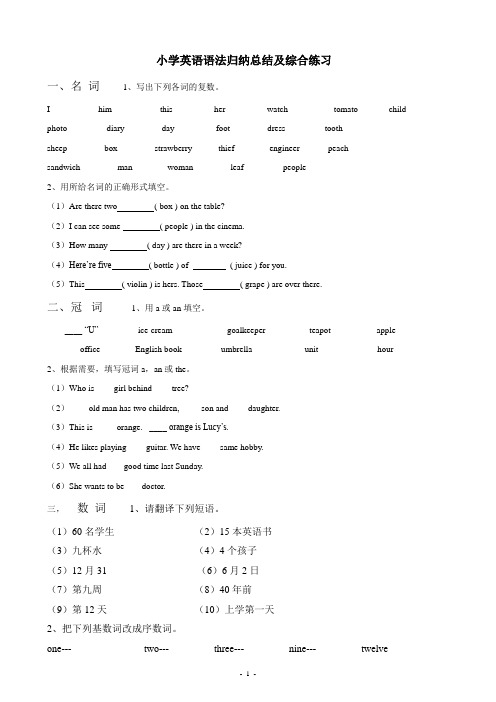
小学英语语法归纳总结及综合练习一、名词1、写出下列各词的复数。
I _________ him _________ this _______ her ______ watch _______ tomato_______child _______ photo ________ diary ______ day________ foot________ dress ________ tooth_______sheep ______ box_______ strawberry _____ thief _______ engineer______ peach______sandwich ______ man______ woman_______ leaf_______ people________2、用所给名词的正确形式填空。
(1)Are there two ( box ) on the table?(2)I can see some ( people ) in the cinema.(3)How many ( day ) are there in a week?(4)Here’re five( bottle ) of ( juice ) for you.(5)This ( violin ) is hers. Those ( grape ) are over there.二、冠词1、用a或an填空。
____ “U” ____ ice-cream ____ goalkeeper ____ teapot ____apple____office ____English book ____umbrella ____unit ____hour2、根据需要,填写冠词a,an或the。
(1)Who is ____girl behind ____tree?(2) ____old man has two children, ____ son and ____daughter.(3)This is ____ orange. ____ orange is Lucy’s.(4)He likes playing ____guitar. We have ____same hobby.(5)We all had____good time last Sunday.(6)She wants to be____doctor.三,数词1、请翻译下列短语。
pep小学英语过去式语法归纳及六套练习题

过去式的规律总结动词分为规则动词和不规则动词一、规则动词的过去式由“动词原形+-ed”构成,具体变化有:1. 直接在词尾加-ed。
如: want—wanted, work—worked, need—needed, clean—cleaned2. 以不发音的e结尾的在词尾加-d。
如:like—liked, live—lived, use—used, move—moved3. 以一个元音字母加一个辅音字母结尾的重读闭音节动词,先双写结尾的辅音字母,再加-ed。
如:stop—stopped, trip—tripped4. 以辅音字母加y结尾的动词,先把y变成i,再加-ed。
如:study—studied, carry—carried, hurry—hurried, marry—married二、不规则动词的过去式见课本后的不规则动词表。
◆过去时的否定句(1)一般动词的否定句一般动词过去时若要变成否定句,只需要在动词前面加did not(=didn’t)就可以了,即:过去时否定句: 主语+ didn’t+动词原形肯定:She watched TV last night. 她昨天晚上看电视了。
否定:She didn’t watch TV last night. 她昨天晚上没有看电视。
肯定:Tom went to the book shop last weekend. 汤姆上周末去书店了。
否定:Tom didn’t go to the book shop last weekend. 汤姆上周没有去书店。
肯定:My grandpa came my home yesterday. 我外婆昨天来我家了。
否定:My grandpa did n’t come my home yesterday. 我外婆昨天没有来我家。
(2)带be 动词的否定句想要将be动词的过去时改为否定句,其实更简单:只要在was或者were 后面加上not 就搞定了!肯定:I was very busy. 我很忙。
(完整版)小学英语语法一本全附练习题
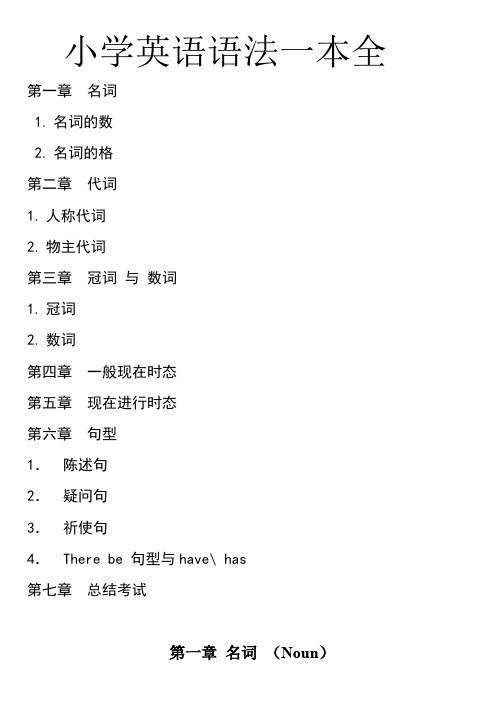
小学英语语法一本全第一章名词1.名词的数2.名词的格第二章代词1.人称代词2.物主代词第三章冠词与数词1.冠词2.数词第四章一般现在时态第五章现在进行时态第六章句型1.陈述句2.疑问句3.祈使句4.There be 句型与have\ has第七章总结考试名词的概念在生活中,我们会接触到各种各样的人和事物,用来表示这些人或事物名称的词就是名词。
一、名词的数名词的数指名词的单数和复数形式。
可数名词表示“一个”时用单数,“两个以上”时用复数;不可数名词表示量时,通常用“数词+单位+of+物质名词”的形式,如 a piece of bread (一片面包),变为复数时,只须将单位名词变为复数,如:two pieces of bread(两片面包)。
*名词复数的构成法则1. 一般情况下在词尾加 s. 词尾读音shop --- shops (商店) 在清辅音后读[ s ]bag --- bags (书包) 在浊辅音后读[ z ]window --- windows (窗户) 在元音后读[ z ]2. 以s, x, sh, ch 结尾的单词在词尾加es。
class --- classes (班级) 词尾读音[ iz ]box --- boxes (盒子)match --- matches (比赛)brush --- brushes (刷子)3. 以“辅音字母+y”结尾的词,变y为i 加es.story --- stories (故事) 词尾读音[ iz ]4. 以“元音字母+y”结尾的词,在词尾直接加skey --- keys 词尾读音[ z ]monkey --- monkeys5.以“o” 结尾的名词,复数一般在词尾加“s”, 但个别加“es”tomato --- tomatoes (西红柿) 词尾读音[ z ]potato --- potatoes (土豆)zoo --- zoos (动物园)photo --- photos (照片)*(以“o”结尾,复数加“es”)口诀:黑人(Negro)英雄(hero),左手拿着西红柿(tomato),右手拿着破土豆(potato),头顶一个大芒果(mango)。
小学三年级阶段英语语法知识总结(带练习及答案)
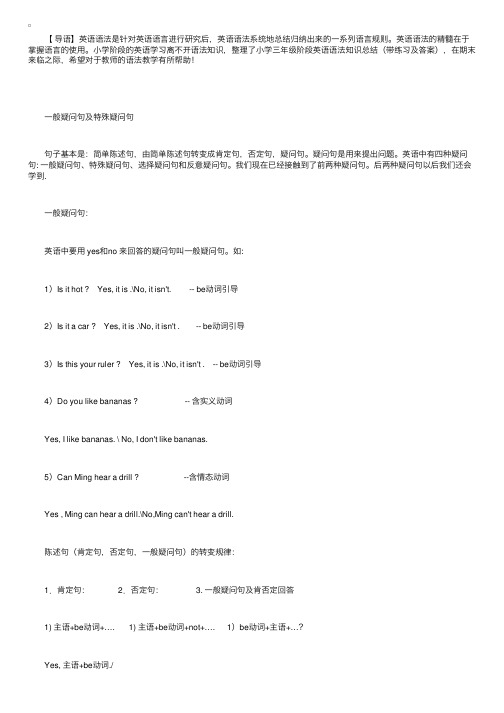
【导语】英语语法是针对英语语⾔进⾏研究后,英语语法系统地总结归纳出来的⼀系列语⾔规则。
英语语法的精髓在于掌握语⾔的使⽤。
⼩学阶段的英语学习离不开语法知识,整理了⼩学三年级阶段英语语法知识总结(带练习及答案),在期末来临之际,希望对于教师的语法教学有所帮助! ⼀般疑问句及特殊疑问句 句⼦基本是:简单陈述句,由简单陈述句转变成肯定句,否定句,疑问句。
疑问句是⽤来提出问题。
英语中有四种疑问句: ⼀般疑问句、特殊疑问句、选择疑问句和反意疑问句。
我们现在已经接触到了前两种疑问句。
后两种疑问句以后我们还会学到. ⼀般疑问句: 英语中要⽤ yes和no 来回答的疑问句叫⼀般疑问句。
如: 1)Is it hot ? Yes, it is .\No, it isn't. -- be动词引导 2)Is it a car ? Yes, it is .\No, it isn't . -- be动词引导 3)Is this your ruler ? Yes, it is .\No, it isn't . -- be动词引导 4)Do you like bananas ? -- 含实义动词 Yes, I like bananas. \ No, I don't like bananas. 5)Can Ming hear a drill ? --含情态动词 Yes , Ming can hear a drill.\No,Ming can't hear a drill. 陈述句(肯定句,否定句,⼀般疑问句)的转变规律: 1.肯定句: 2.否定句: 3. ⼀般疑问句及肯否定回答 1) 主语+be动词+…. 1) 主语+be动词+not+…. 1)be动词+主语+…? Yes, 主语+be动词./ No, 主语+be动词+not. I am a teacher. I am not a teacher. Are you a teacher? --Yes, I am./ No, I am not. My mother is thin. My mother is not /isn't thin. Is your mother thin? --Yes, she is./ No, she isn't. They are insects. They are not/aren't insects. Are they insects? --Yes. they are./ No, they aren't. 2) 主语+情态动词can+… 2) 主语+情态动词can+ not+…. 2)情态动词can+主语+…? Yes, 主语+情态动词can/ No,主语+情态动词can+ not He can jump. He can not/can't jump. Can he jump? --Yes,he can./ No, he can't. 3) 主语+动词+…. 3) 主语+助动词do/does+not 3)助动词do/does+主语 +…. 动词原形 +….动词原形? Yes, 主语+助动词do/does. No, 主语+助动词do/does+not. He likes to eat apples. He doesn't like to eat apples. Does he like to eat apples? Yes,he does./ No,he doesn't. We like to eat apples. We don't like to eat apples. Do you like to eat apples? Yes,we do. /No,we don't. ⼆. 祈使句:表⽰请求、命令、建议或劝告等的句⼦叫祈使句,主语you常省略。
小学英语语法及练习题
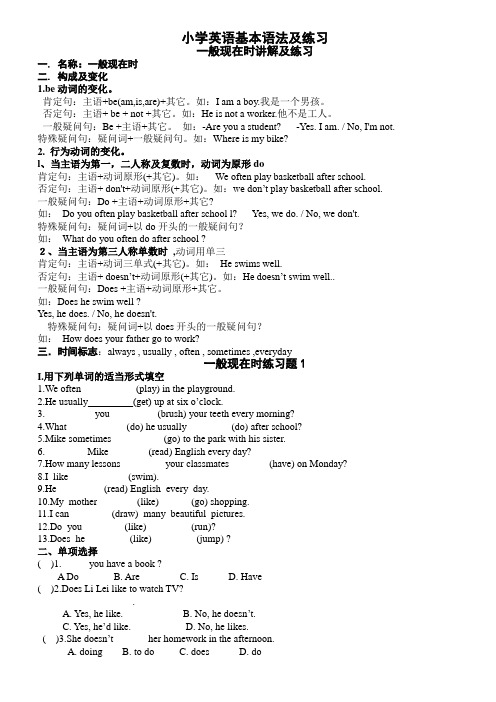
小学英语基本语法及练习一般现在时讲解及练习一. 名称:一般现在时二. 构成及变化1.be动词的变化。
肯定句:主语+be(am,is,are)+其它。
如:I am a boy.我是一个男孩。
否定句:主语+ be + not +其它。
如:He is not a worker.他不是工人。
一般疑问句:Be +主语+其它。
如:-Are you a student? -Yes. I am. / No, I'm not. 特殊疑问句:疑问词+一般疑问句。
如:Where is my bike?2. 行为动词的变化。
l、当主语为第一,二人称及复数时,动词为原形do肯定句:主语+动词原形(+其它)。
如:We often play basketball after school.否定句:主语+ don't+动词原形(+其它)。
如:we don’t play basketball after school.一般疑问句:Do +主语+动词原形+其它?如:Do you often play basketball after school l? Yes, we do. / No, we don't.特殊疑问句:疑问词+以do开头的一般疑问句?如:What do you often do after school ?2、当主语为第三人称单数时,动词用单三肯定句:主语+动词三单式(+其它)。
如:He swims well.否定句:主语+ doesn’t+动词原形(+其它)。
如:He doesn’t swim well..一般疑问句:Does +主语+动词原形+其它。
如:Does he swim well ?Yes, he does. / No, he doesn't.特殊疑问句:疑问词+以does开头的一般疑问句?如:How does your father go to work?三.时间标志:always , usually , often , sometimes ,everyday一般现在时练习题1I.用下列单词的适当形式填空1.We often___________(play) in the playground.2.He usually_________(get) up at six o’clock.3.__________you _________(brush) your teeth every morning?4.What____________(do) he usually_________(do) after school?5.Mike sometimes __________(go) to the park with his sister.6.________ Mike________(read) English every day?7.How many lessons_________your classmates________(have) on Monday?8.I like ___________ (swim).9.He _________(read) English every day.10.My mother________(like) ______(go) shopping.11.I can ________(draw) many beautiful pictures.12.Do you ________(like)_________(run)?13.Does he_________(like)_________(jump) ?二、单项选择( )1._____ you have a book ?A Do B. Are C. Is D. Have( )2.Does Li Lei like to watch TV?______________.A. Yes, he like.B. No, he doesn’t.C. Yes, he’d like.D. No, he likes.( )3.She doesn’t ______ her homework in the afternoon.A. doingB. to doC. doesD. do( )4.How ____ Mr. Smith ______ to England?A. do, goB. is , goC. does, goD. does , goes( )5. _____ she ______ home at six every day?A. Is , leaveB. Does , leaveC. Is , leavesD. Does , left三、按要求完成下列各题1.Tomorrow is Saturday.(变成一般疑问句)_________ ________ Saturday ?2.Does he play basketball every weekend? (肯定回答)Yes, ______ _______.3.She looks like her sister.(变一般疑问句)_____ she ______ like her sister ?4.Peter and Sam look the same.(一般疑问句)______ they _____ the same ?5.Do they always go to the movie (电影院) on Sundays ? (否定回答)No, _______ _______.现在进行时态精讲精练1.名称:现在进行时例:I am reading an English book now. 我现在正在读一本英语书。
小学英语语法大全完美版(含练习)

目录概述 (1)第一讲句子 (2)第二讲名词 (4)第三讲冠词 (7)第四讲代词 (9)第五讲形容词和数词 (11)第六讲副词 (14)第七讲介词 (15)第八讲连词 (17)第九讲动词 (18)第十讲语法的基本概念 (20)第十一讲一般现在时 (22)第十二讲现在进行时 (24)第十三讲一般过去时 (26)第十四讲一般将来时 (28)第十五讲句法 (30)第十六讲话题 (32)概述英语语法是什么:英语语法是针对英语语言进行研究后,英语语法系统地总结归纳出来的一系列语言规则。
英语语法的精髓在于掌握语言的使用。
英语语法是分类的,分为词法和句法。
小学英语语法和初高中相比较,只是在语法数量和难易程度上有差别。
英语有些方面是有一些规律可循的,但是英语还有它另外一个显著的特点,那就是知识点的零碎、分散。
万丈高楼从地起,想要学好英语,那就需要注重英语基础。
基础打牢才会越学越轻松。
对于小学语法的讲解,将会从词法、句法、时态三个方面展开:【词法】八大词法:名词形容词副词代词动词数词介词冠词【句法】七种句型:陈诉句、疑问句(一般疑问句、选择疑问句、特殊疑问句)祈使句、被动句、There be句型、if条件句、感叹句【时态】四种时态:一般现在时、现在进行时、一般过去时、一般将来时第一讲:句子第二讲:名词名词的定义:名词是指表示人和事物名称的词,可以分为专有名词和普通名词两大类。
一:名词的种类:1e.g. Jim Green,New York,Bank of China,Peking University星期、月份、节日、学科、报刊名也是专有名词。
e.g. Monday,May,Christmas,Spring Festival,Maths,China Daily2、普通名词:表示一类人或物或抽象概念的名称。
普通名词又可以分为四类:个体名词—— 表示某类人或东西中的个体,如:student , desk集体名词—— 表示若干个体组成的集合体,如:class , family物质名词—— 表示无法分为个体的物质名称,如:water , rice , sand,hair抽象名词—— 表示情感,状态,品质等抽象名称,如:love ,carelessness个体名词和集体名词多数可以用数目来计算,称为可数名词,有单、复数形式;物质名词和抽象名词通常无法用数目计算,称为不可数名词,一般只有一种形式。
完整版)小学英语语法及练习题
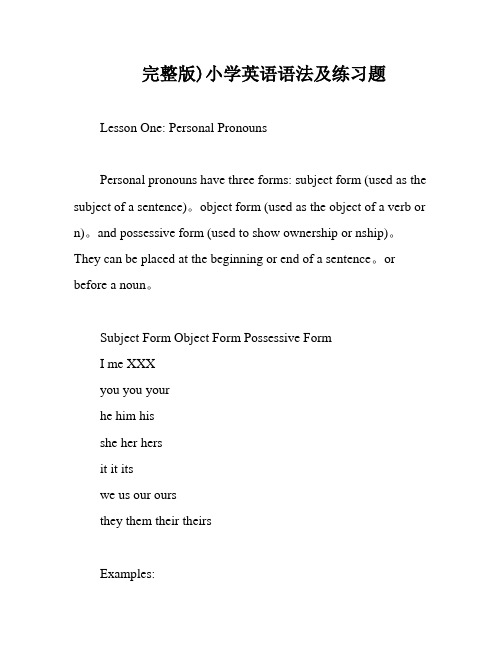
完整版)小学英语语法及练习题Lesson One: Personal PronounsPersonal pronouns have three forms: subject form (used as the subject of a sentence)。
object form (used as the object of a verb or n)。
and possessive form (used to show ownership or nship)。
They can be placed at the beginning or end of a sentence。
or before a noun。
Subject Form Object Form Possessive FormI me XXXyou you yourhe him hisshe her hersit it itswe us our oursthey them their theirsExamples:1.Are these your pencils。
Yes。
they are ours.2.Whose is this pencil。
It's XXX.3.I love them very much.4.XXX.5.Miss Li often looks after her XXX.6.Are these their bags。
No。
they XXX.7.That is not my kite。
That kite is very small。
but mine is very big.8.The dress is hers。
Give it to her.9.Is this your watch。
No。
it's not XXX.1.This bike is my sister's。
It belongs to her.2.This isn't my book。
外研社小学英语一起小学五年级上语法总结及练习题

外研社小学英语一起小学五年级上语法总结及练习题I。
There be句型的一般现在时与一般过去时1.There be一般现在时:There be句型用来表示某地是否有某物或某人,构成方式为:be动词后紧跟着名词。
肯定句的形式为:There is + 可数名词单数/不可数名词 + 地点,There are + 可数名词复数 + 地点。
否定句则在is/are后面加上not,即There XXX’t + 可数名词单数/不可数名词 + 地点,There aren’t + 可数名词复数 + 地点。
一般疑问句的形式为:Is/Are there + 名词 + 地点 + 地点?回答肯定为Yes。
there is/are。
否定为No。
there isn’t/aren’t。
针对数量提问的特殊疑问句的形式为:How many + 名词复数+ are there + 地点?How much + 不可数名词 + is there + 地点?2.There be一般过去时:There be句型用来表示过去某地是否有某物或某人,时间状语可以是昨天、早上、晚上等,也可以是由“last+一时间名词”构成的短语,如last night。
last year等,还可以是由“时间段+ago”构成的短语,如a moment ago。
a short time ago。
an hour ago等。
肯定句的形式为:There was + 可数名词单数/不可数名词 + 地点,There were + 可数名词复数 + 地点。
否定句则在was/were后面加上not,即XXX 可数名词单数/不可数名词 + 地点,There weren’t + 可数名词复数 + 地点。
一般疑问句的形式为:Was/Were there + 名词 + 地点 + 地点?回答肯定为Yes。
there was/were。
否定为No。
XXX’t。
针对数量提问的特殊疑问句的形式为:How many + 名词复数 + were there + 地点?How much + 不可数名词 + was there + 地点?就近原则:在there be句型中,be动词用单数还是复数取决于离它最近的那个名词的数量。
- 1、下载文档前请自行甄别文档内容的完整性,平台不提供额外的编辑、内容补充、找答案等附加服务。
- 2、"仅部分预览"的文档,不可在线预览部分如存在完整性等问题,可反馈申请退款(可完整预览的文档不适用该条件!)。
- 3、如文档侵犯您的权益,请联系客服反馈,我们会尽快为您处理(人工客服工作时间:9:00-18:30)。
小学英语语法总结及练习一、名词复数规则1. 一般情况下,直接力口 -s ,如:book-books, bag-bags, cat-cats, bed-beds2. 以 s. x. sh. ch 结尾,力口 -es ,如:bus-buses, box-boxes, brush-brushes, watch-watches3. 以 辅音字母 y"结尾,变 y 为 i,再力口-es ,如:family-families, strawberry-strawberries 4 .以"或 fe "结尾,变 f 或 fe 为 v,再加-es ,如:knife-knives , leaf ----------- leaves 5. 不规则名词复数:man-men, woma n-wome n, policema n-policeme n, policewoma n-policewome n, child-children, foot-feet, tooth-teethfish-fish, deer-deer, sheep-sheep, people-people, Chin ese-Chi nese, Japa nese-Japa nese写出下列各词的复数二、一般现在时一般现在时基本用法介绍: 【No. 1】一般现在时的功能1. 表示事物或人物的特征、状态。
如: The sky is blue.天空是蓝色的。
2. 表示经常性或习惯性的动作。
如: I get up at six every day.我天天六点起床。
3. 表示客观现实。
如: The earth goes around the sun 地球绕着太阳转。
一般现在时的构成:1. be 动词:主语+ be(am,is,are)+其它。
如:I am a boy.我是一个男孩。
2. 行为动词:主语+行为动词(其它)。
如:We study English.我们学习英语。
当主语为第三人称单数(he, she,it)时,要在动词后加"-s"或"-es"。
女口: Mary likes Chinese.玛丽喜欢汉语。
【No. 2】一般现在时的变化 1. be 动词的变化。
否定句:主语+ be not +其它。
女口: He is not a worker.他不是工人。
一般疑问句:Be +主语+其它。
女口: -Are you a student? -Yes. I am. / No, I'm not.非凡疑问句:疑问词+—般疑问句。
如: Where is my bike?2. 行为动词的变化。
否定句:主语+ don 't( does n't)+ 动词原形(其它)。
如:I don't like bread.man _____ woman ______her _____ diary ______ dress ________ strawberry _____bus ______当主语为第三人称单数时,要用does n't构成否定句。
如:He does n't often play.—般疑冋句:Do( Does )+主语+动词原形+其它。
女口:- Do you ofte n play football? - Yes, I do. / No, I don't.当主语为第三人称单数时,要用does构成一般疑问句。
女口:- Does she go to work by bike? - Yes, she does. / No, she does n't.动词s的变化规则:1. 一般情况下,直接加-s,如:cook-cooks, milk-milks2. 以s. x. sh. ch. o结尾,力口-es,如:guess-guesses, wash-washes, watch-watches, go-goes3. 以辅音字母y”结尾,变y为i,再加-es,如:study-studies一般现在时用法专练:一、写出下列动词的第三人称单数drink go stay makelook have pass carrycome watch pla nt flystudy brush do teachwash二、用括号内动词的适当形式填空。
1. He ofte n _____ (have) dinner at home.2. Daniel and Tommy ______ (be) in Class One.3. We _______ (not watch) TV on Mon day.4. Nick ______ (not go) to the zoo on Sun day.5. _____ they _______ (like) the World Cup?6. What ______ they ofte n _____ (do) on Saturdays?7. _____ your pare nts _______ (read) n ewspapers every day?8. The girl ______ (teach) us En glish on Sun days.9. She and I _______ (take) a walk together every eve ning.10. There _______ (be) some water in the bottle.11. Mike _____ (like) cooki ng.12. They _____ (have) the same hobby.13. My aunt ______ (look) after her baby carefully.14. You always _______ (do) your homework well.15. I _______ (be) ill. I ' nstaying in bed.16. She ______ (go) to school from Mon day to Friday.17. Liu Tao ______ (do) not like PE.18. The child ofte n _____ (watch) TV in the eve ning.19. Su Hai and Su Yang _______ (have) eight less ons this term.20. —What day ______ (be) it today?—It ' S S turday三、现在进行时1 •现在进行时表示现在正在进行或发生的动作,也可表示当前一段时间内的活动或现阶段正在进行的动作。
2. 现在进行时的肯定句基本结构为:be+动词ing.3. 现在进行时的否定句在be后加not。
4 •现在进行时的一般疑问句把be动词调到句首。
5.现在进行时的特殊疑问的基本结构为:特殊疑问词+be+主语+动词ing?但疑问词当主语时其结构为:特殊疑问词+be+动词ing?动词加ing的变化规则1. 一般情况下,直接加ing,如:cook-cooking2. 以不发音的e结尾,去e加ing, 如: make-making, taste-tasting3. 假如末尾是一个元音字母和一个辅音字母,双写末尾的辅音字母,再加ing, 女口:run-running, stop-stopping现在进行时专项练习:一、写出下列动词的现在分词:1. The boy _________________ ( draw)a picture now.2. Liste n .Some girls ______________ ( sin g)i n the classroom .3. My mother ________________ ( cook )some nice food now.4. What ____ you ______ ( do ) now?5. Look . They _____________ ( have) an En glish less on .6. They __________ (not ,water) the flowers now.7. Look! the girls ______________ (dance )in the classroom .8. What is our granddaughter doing? She _______ (listen ) to music.9. It ' 5so' clockiow. We ____________ (have)supper now10. ____ Helen ___________ (wash )clothes? Yes ,she is .四、将来时理论及练习1、概念:表示将要发生的动作或存在的状态及打算、计划或预备做某事。
句中一般有以下时间状语:tomorrow, n ext day(week, mon th, year …),so on,the day after tomorrow (后天)等。
2、基本结构:① be going to do;②will do.3、否定句:在be动词(am, is, are)后加not或情态动词will后加not成won'。
例如:I 'ngoi ngto have a picnic this after noon.f I ' m not going to have a pic nic this after noon.4、同义句:be going to = willI am going to go swimming tomorrow (明天).=I will go swimming tomorrow. 练习填空:1. 我打算明天和朋友去野炊。
I _____________________ have a picnic with my frie nds.I ________ h ave a picnic with my frie nds.2. 我们将要学习英语We ______________________ lear n En glish.We ________ lear n En glish.五、一般过去时1•一般过去时表示过去某个时间发生的动作或存在的状态,常和表示过去的时间状语连般过去时也表示过去经常或反复发生的动作。
2. Be动词在一般过去时中的变化:⑴am禾口is在一般过去时中变为was°( was not=wasn')⑵are在一般过去时中变为were°( were not=weren' )t3. 句中没有be动词的一般过去时的句子否定句:did n '动词原形,如:Jim did n 'go home yesterday.动词过去式变化规则:1. 一般在动词末尾加-ed,如:work-worked , cook-cooked2. 结尾是e 加d,如:live —lived3. 末尾只有一个元音字母和一个辅音字母的重读闭音节,应双写末尾的辅音字母,再加女口:stop-stopped4. 以辅音字母y"结尾的,变y为i, 再加-ed,如:study-studied5. 不规则动词过去式:am,is-was, are-were, do-did, see-saw, say-said, give-gave, get-got,go-we nt,come-came, have-had, eat-ate, take-took, run-ra n, sin g-sa ng, put-put, read-read, write-wrote, draw-drew, drin k-dra nk, swim-swam, sit-sat过去时练习写出下列动词的过去式is\am ________ plant ___________ are ____________ do ____________drink _________ play ____________ go __________ make _____________does dance worry asktaste _________ eat ____________ put ________ pass _________ kick ________ Be动词的过去时练习(1)I. 1 _____ at school just now.2. He ________ a t the camp last week.3. We _______ s tude nts two years ago.4. They _______ on the farm a mome nt ago.5. Yang Li ng ______ e leve n years old last year.6. There ______ an apple on the plate yesterday.7. There some milk in the fridge on Sun day.8. The mobile pho ne on the sofa yesterday eve ning.9. I an En glish teacher now.10. She ______ h appy yesterday.II. They ______ glad to see each other last mon th.行为动词的过去时练习(2)1.1 _____ (watch) a carto on on Saturday.2. Her father _______ (read) a n ewspaper last ni ght.3. We ________ to zoo yesterday, we ____ to the park. (go)4. ____ you _______ (visit) your relatives last Spring Festival?5. ____ he ________ (fly) a kite on Sun day? Yes, he _____ .6. Gao Sha n ______ (pull) up carrots last Nati onal Day holiday.7.1 __________ (sweep) the floor yesterday, but my mother ______ .8. What ______ s he ______ (find) in the garde n last morning?She ____________ (find) a beautiful butterfly.小学英语六年级语法训练语法及练习1 be 动词Be 动词的用法:口诀:我用am,你用are, is 用在他她它,复数全用are 。
